‘What a Christmas Present! Deportation!’: The Revealing History of Ellis Island’s Holiday Parties
Children at Ellis Island in the early 1900s, displaying their Christmas gifts. (Photo: AP Images)
In 1931, Sam Lee traveled 7,000 miles from his native China to begin a new life in New York City. On the grueling journey, Lee acquired a strange cough, and when he arrived at Ellis Island, immigration officials detained him while they determined if he was healthy enough to enter the United States. As he lay in bed one afternoon, a rotund man with a white beard, red suit, and giant bag suddenly loomed above him.
A startled Lee ducked under the covers, while the nurses chuckled and told him the news—Santa Claus had arrived at Ellis Island.
The New York Herald Tribune’s (perhaps exaggerated) retelling of Sam Lee’s story claimed he recited an ancestral prayer when surprised and that the nurses “convinced him that Santa Claus was a beneficent old gentleman of the Western World.” But if these seemingly stereotypical details are hard to confirm, the story did underscore one important point—for immigrants, U.S. authorities, and relief workers throughout New York City, Christmas at Ellis Island was a big, often baffling, deal.
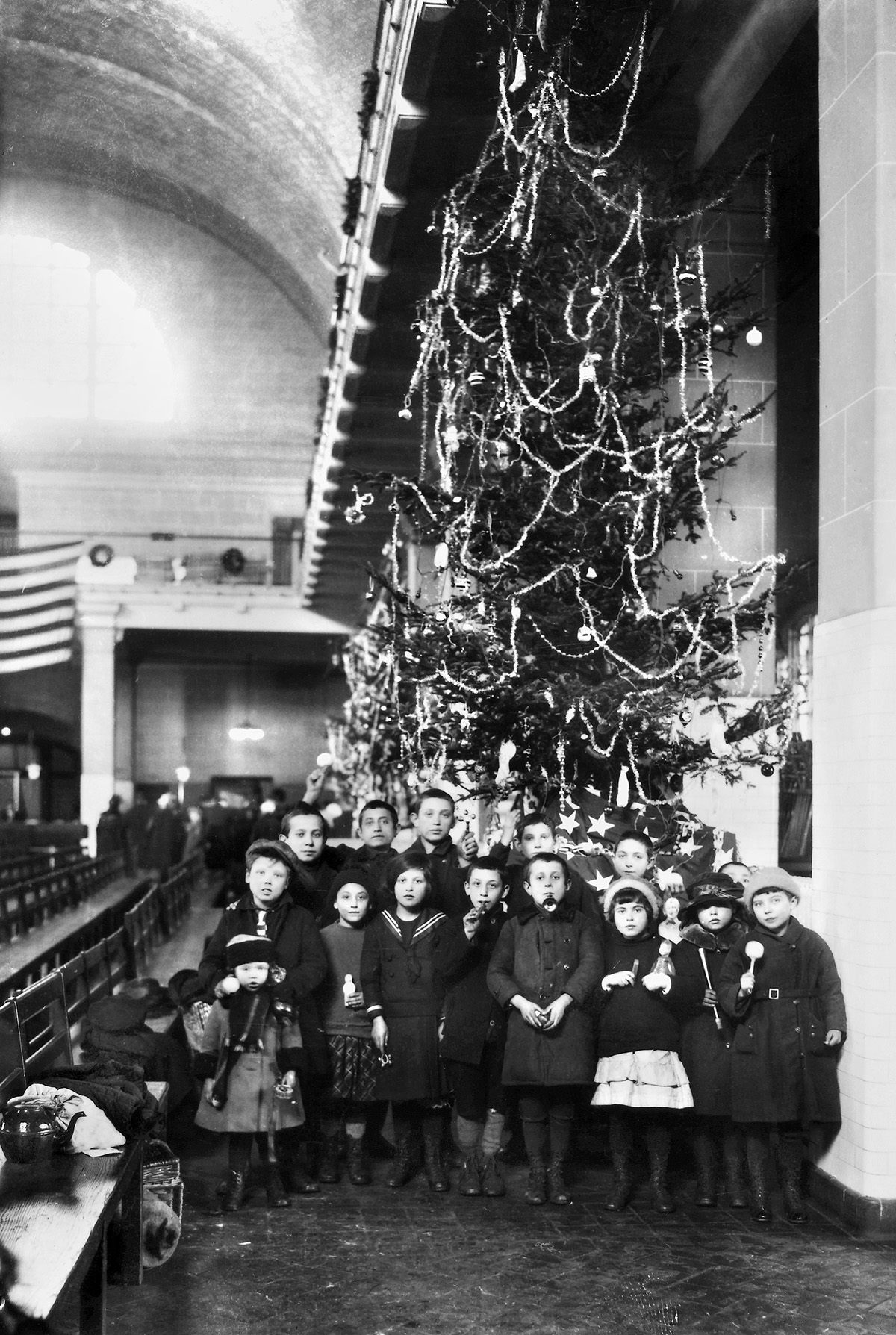
A group of immigrant children in front of a Christmas tree inside the registry room at Ellis Island, 1920. (Photo: Granger NYC)
Visits from Santa were only one element of the strange pageant of patriotism, evangelism, and humanitarianism at America’s main port of entry. Ellis Island operated from 1892 to 1954, and was a media staple throughout the 20th century, as about 80 percent of all immigrants to the United States passed through its doors. Just 1.5 miles off the southern tip of Manhattan, inspectors, doctors, and other government authorities sifted through the masses of new arrivals, separating desirable from undesirable immigrants.
If Ellis Island is remembered today as America’s welcoming gate, the media coverage of the time created a more complicated picture. There were joyful stories of the immigrants allowed into the U.S., alongside exposés of discriminatory procedures, terrible food, and arbitrary exclusion decisions. Several Ellis Island commissioners identified interacting with the media as the single most taxing element of their job. But the press Ellis Island received during the holidays was especially colorful and, in the island’s early years, extremely positive.
“Everyone from the tiniest baby to the oldest man received a gift, candy, oranges, toys, soap, handkerchiefs, etc. Not one was overlooked or passed by,” journalists glowed.
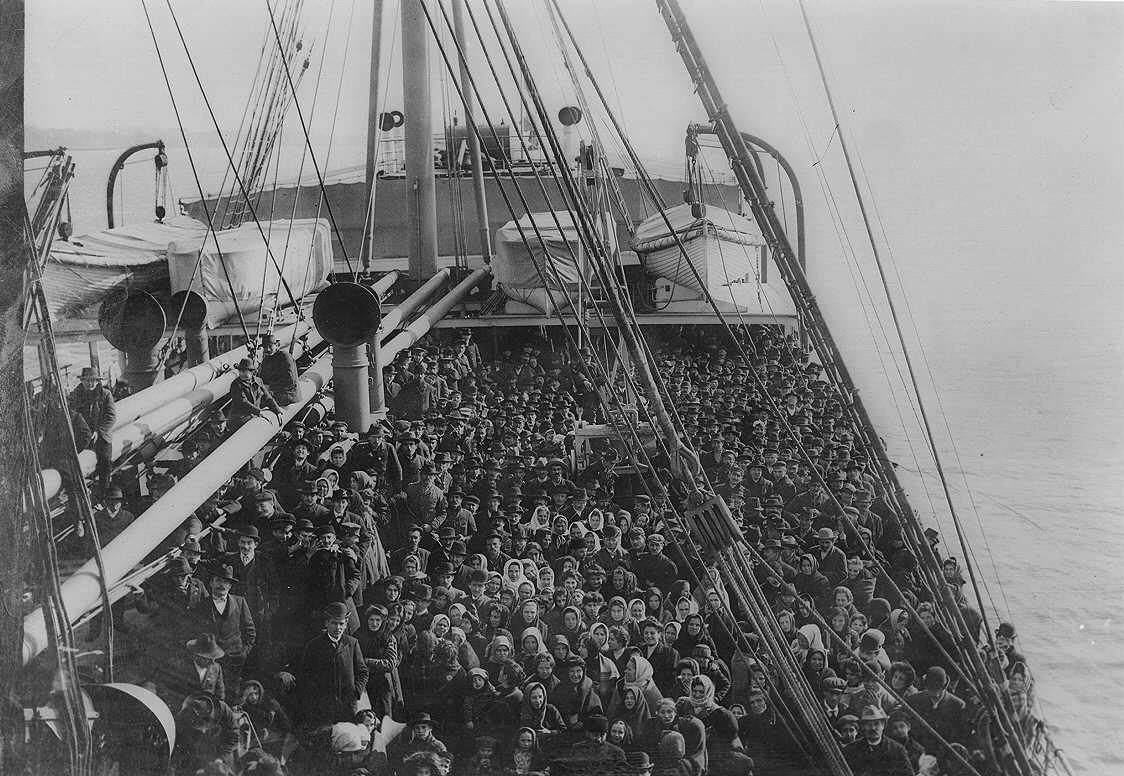
Immigrants on the SS Patricia arrive at Ellis Island, c. 1906. (Photo: Library of Congress)
The Ellis Island Christmas parties often incorporated a range of cultures; one particularly extravagant event in 1931 included a Hungarian dance, Russian Gypsy songs, Italian folk songs, a Japanese xylophonist, a Spanish tenor, and a German Christmas Carol. The day concluded with “Holy Night” sung in every language spoken at the island—a reporter wrote that since the Chinese did not have words for the tune, they “assisted by humming.” Annual yuletide festivities became an opportunity for the United States to present an idealized vision of American inclusivity—one that celebrated diverse traditions and warmly welcomed newcomers into the fold. Yet organizers of these celebrations also saw the holidays as a means to introduce the new arrivals to the middle class, Protestant customs and character of the United States—bibles, tracts, and American flags were frequently given as gifts and religious hymns rung through the vaunted halls each December.
Perhaps the holiday celebrations veered between heartwarming and heavy-handed because the stakes of these celebrations were so high. Christmases at Ellis Island served an important role in creating the public perception of the site. The holidays were a public relations challenge for the Bureau of Immigration—with hundreds of immigrants in detention or quarantine, at no other time was the lack of freedom at the inspection station so jarringly on display.
Because on Christmas, especially, no one was staying at Ellis Island by choice.
“A Truly Christian Christmas”
During Ellis Island’s peak years from 1900 to 1914, the winter scene inside the immigration station was, by all accounts, spectacular. The Great Hall, with its soaring vaulted ceilings and glossy tiled halls, featured nine Christmas trees, each decked with colored lights. At one end of the hall a giant, glowing electric sign read “Merry Christmas”—likely the first electric sign many of the immigrants had ever seen. Each balcony railing and pillar was wrapped gracefully in evergreen wreaths and American flags. The largest tree in the room, often topping 30 feet, stood at the opposite end of the gallery; under its branches, immigrants peered at the hundreds of neatly wrapped packages, one for each person held at Ellis Island on Christmas Day.
For the immigrants arriving at Ellis Island at the turn of the century, the first building they entered in the United States was quite a sight to behold.
An Ellis Island Christmas didn’t just mean flashy decorations; it meant a day-long extravaganza celebrating both the holiday and the glories of America. The day began with an address by the Ellis Island commissioner (which, of course, very few of the immigrants actually understood) followed by speeches from dozens of local clergy in multiple languages. Then came a variety of musical acts—in some years a full orchestra or a professional opera singer performed, in another, a single detained immigrant played an organ—and immigrants and workers joined in singing Christmas carols, along with the national anthem and “My Country Tis of Thee.” Finally, the organizers distributed a gift to each immigrant and invited them into the Great Hall for a multi-course Christmas dinner.
![Emigrants in "pens" at Ellis Island, New York, probably on or near Christmas --note the decorations]](https://img.atlasobscura.com/hGEuBqBCrUrz5lzJbTm3gqGbwDiiPzJmChmM2_GxQ78/rs:fill:12000:12000/q:81/sm:1/scp:1/ar:1/aHR0cHM6Ly9hdGxh/cy1kZXYuczMuYW1h/em9uYXdzLmNvbS91/cGxvYWRzL2Fzc2V0/cy9jMjU3YmU2ZDVj/ZTZhN2Q3NGFfM2Ey/MzQyNHIuanBn.jpg)
New arrivals at the ”pens” at Ellis Island, New York, aound Christmas, c. 1906 - note the decorations. (Photo: Library of Congress)
Women ran the show during Christmas. During the Progressive Era, the first two decades of the 20th century, middle and upper middle-class women became newly involved in the plight of the downtrodden—and in particular, of the immigrant masses. As industrialization swept through the country, progressive reformers grew concerned with how the expanding slums in American cities, the influx of new immigrants, and the mounting strife over labor conditions would shape the U.S. To make matters worse, the new immigrants were thought to be quite culturally different from previous arrivals—swarthy, backwards, and comparatively untamed. Women were frequently at the forefront of “civilizing missions” in New York City and other urban areas. The Home Missionary, a journal documenting reform and relief efforts in the U.S., reported on missionary women’s efforts at Ellis Island: “The Government and the missionary world joined hands to make the whole day a truly Christian Christmas.”
If immigration officers saw the celebrations at Ellis Island as good public relations, missionaries and local aid organizations approached them as a decidedly evangelical endeavor. How better to preach the gospel to new immigrants then with a big party and a literally captive audience? Missionary journals proudly described distributing copies of the Scripture to immigrants like “the Persians” who had little knowledge of Christianity. They also reprinted letters from immigrants effusively thanking them, such as one correspondence from a Swedish immigrant who wrote, “I shall always keep the Bible as a dear remembrance of my fist step on American ground, and will never forget the American people’s gentle ways to treat strangers.” In 1907, the New York Observer confidently predicted that the immigrants “will be happier and stronger all the year, they will be better citizens in the years to come, because over the door to the new land hung the Christmas Star and because the ‘Man at the Gate’ interpreted for them the genius of American life—the spirit of Christian brotherhood.”
Not all Christian denominations were created equal, however. The National Catholic Welfare Conference didn’t host its first Christmas mass at Ellis Island until 1924, after decades of jockeying for influence. Worse still (at least from the perspective of the Protestant evangelists), Catholic charities were willing to acknowledge the religious diversity of the new immigrants. In asking for donations of gifts, Catholic organizations specifically requested that parishioners not send religious items such as rosaries, because the gifts would be distributed indiscriminately and it would be difficult to say which immigrants were Catholic. This was a far cry from the missionary work.

A Dutch family arrives at Ellis Island, c. 1900. (Photo: Library of Congress)
And the media offered few reflections on non-Christian holiday celebrations at Ellis Island—a glaring omission considering the large number of Jewish immigrants moving through the island. At the first Ellis Island Christmas party in 1903, one observer said that “a peculiarity of the celebration was the number of Jews who attended, for, as the ceremonies were religious in character, the Jews had been given permission to remain away and special provision had been made for them in the way of gifts.” A few New York Times pieces made reference to Hanukkah observations, and the 1940s saw the first Hanukkah dinners and religious services take place on the island.
If the predominately European immigrants were viewed as sympathetic figures, immigrant children were the most sympathetic of them all. For the holiday, each child on Ellis Island received a toy—dolls for the girls, rubber balls for boys, and rattles for the smallest children—as well as candy and other treats. Onlookers used the Christmas festivities to show the pure, perhaps even morally superior character of the poor immigrant children. A long essay in the 1921 New York Times compared the behavior of children at a Christmas party at the Ritz-Carlton to that of the children at Ellis Island. The wealthy children appeared bored and unimpressed while their mothers flitted around the swanky party in silk and velvet gowns, showering them with impressive gifts, the paper reported. Meanwhile the immigrant children were delighted at their “plainer tree” and unelaborate presents. The article suggested that the immigrant children might be the Ritz-Carlton guests of tomorrow, swiftly inserting them into the national narrative of upward mobility and opportunity.
Overall, Christmases provided an effective tool in fostering a humanitarian image of Ellis Island. Few articles failed to mention the smiling faces of immigrant children, the voices singing together in their many foreign tongues, or the families looking on in awe at the bounty and modernity of an American celebration. “To make such captives happy on Christmas Day seemed a miracle,” a reporter from the Boston Daily Globe wrote.
‘The Saddest Christmas in Ellis Island History’
As Ellis Island’s role changed, so too did the holiday celebrations. In the peak years of Ellis Island, immigrants’ stays on the island were brief – generally under a week– while immigration authorities reviewed the cases of immigrants that looked too sick or poor for admission. But by the time Ellis Island closed in 1954, it primarily served as a site for holding deportees, “enemy aliens,” and those accused of subversive (usually communist) activities.
As detentions grew longer, and deportations became the norm rather than the exception, the tone of the holidays shifted. Rather than a marker of America’s welcoming spirit, the holidays became a marker of increasingly extended captivity.
On May 19, 1921, President Warren G. Harding passed the Emergency Quota Act, the first federal law to limit the immigration of Europeans to the United States. In the preceding years, the demographics of American immigration had changed, with the majority of new arrivals coming from southern and Eastern Europe—many Americans argued that these immigrants were not of the same high stock as previous waves of western and northern European immigrants, and could not assimilate into American life with the same ease. (Arguments that, ironically, had been made about the “old stock” immigrants just a few decades prior.) Nativist sentiment had been mounting throughout the 20th century and World War I brought new concerns about a potential mass exodus of European refugees. There was near consensus in Congress that America could no longer keep its gates open; the discretionary sifting of immigrants by Ellis Island officers was replaced by the blunt instrument of quota law, capping the number of immigrants that could enter from each country.
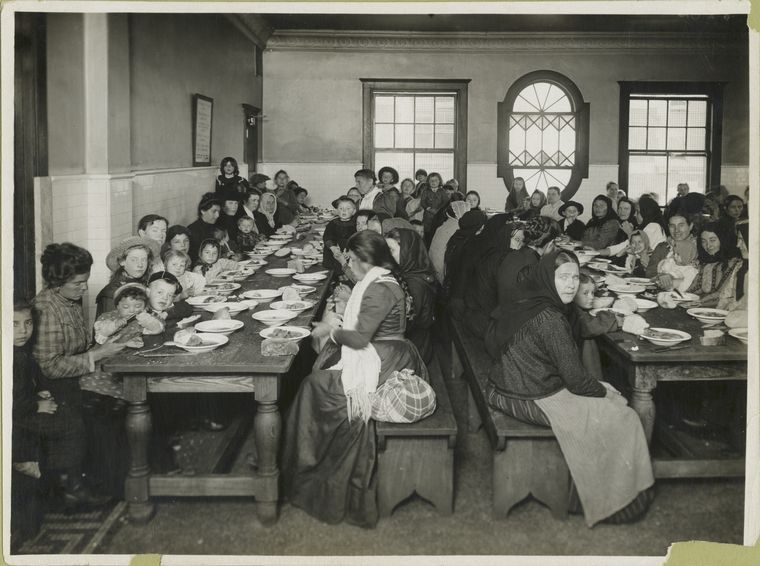
Immigrants eat at Ellis Island, c. 1902-1913. (Photo: New York Public Library/flickr)
The immigration officers of Ellis Island predicted that 1921 would be “the saddest Christmas the island has ever seen,” as over 1,000 disappointed men, women, and children who arrived in excess of their national quotas would spend the holiday at Ellis Island awaiting deportation. Media coverage was often empathetic towards the immigrants’ plight, drawing stark contrasts between the joy of the holiday season and the bleakness of their predicament. As the quota law predicted, many of the excludable immigrants came from regions of Europe that had been devastated by World War I. The media reported that many of these detainees, particularly those from Italy and Poland, had fled oppression and sold all of their worldly possessions to book passage on a ship to the United States. If in the past immigrants spending the holidays at Ellis Island were “buoyed up by the thoughts of the land of promise lying beyond the welcoming Statue of Liberty” they would now be “made only more bitter, by the realization that they are unhappy in the midst of rejoicing.”
In the hailstorm of bleak media attention, Secretary of Labor James J. Davis, himself an immigrant from Wales, made an unprecedented (and by all accounts, totally unilateral) decision to temporarily free the immigrants held at Ellis Island. Just two days before Christmas, Secretary Davis announced that all of the deportees, save a few with contagious illnesses, would be released into the U.S. for 90 days. He wrote to Ellis Island Commissioner Robert E. Tod in December 1921:
“This is the Christmas season and I am going to do what I can for these poor people who have ben brought here and left here in defiance of the law. It is no fault of theirs; they sailed from home in good faith and have landed here to face the bitterest of hardship at the time of the year when the rest of humanity is given to good cheer.”
After three months had elapsed, the released immigrants were expected to return to Ellis Island to board ships back to their home countries. “The cheerful tidings from Washington came so unexpectedly that the delight of the aliens became almost a frenzy,” wrote the Los Angeles Times, “Many had been in downcast spirits at the prospect of a penned-in Christmas followed by deportation from the land to which they had come with high hopes.”
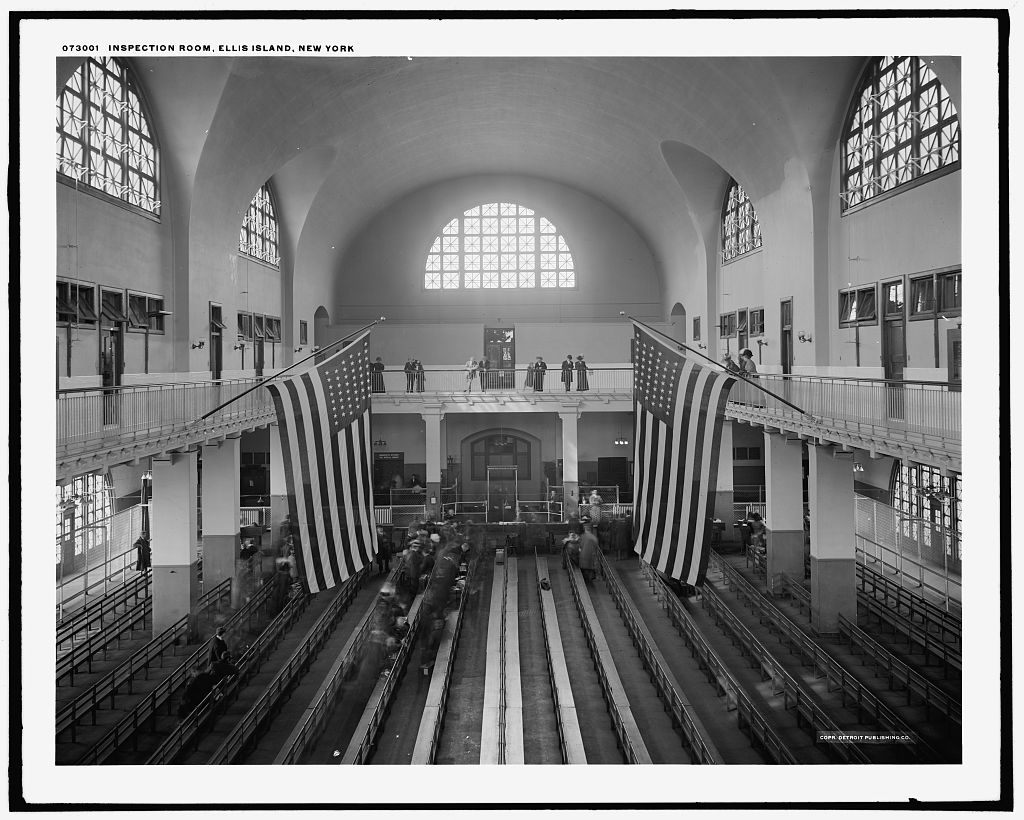
Inspection room, Ellis Island, New York, between 1910 and 1920. (Photo: Library of Congress)
Masses of immigrants, primarily Hungarians, Poles, and Greeks, signed paperwork to be released on bond then embarked upon ferries for a short ride into New York City. Authorities alerted local immigrant aid agencies of the incoming arrivals, and the pastor of a local Hungarian church telegrammed President Harding to personally thank him for releasing his countrymen from detention. Those who did not have the means to travel to family were treated to an enormous—and distinctively American—turkey dinner; the menu consisted of “a ton and a half of Vermont turkey and a big hogshead of New Jersey cranberries to go round.”
Davis’ radical act was lauded by the press as a bold humanitarian gesture, in the truest spirit of the holiday (“Davis Plays St. Nicholas!” “Holiday Liberty!”)—but it also made the Bureau of Immigration’s internal conflict on the quota legislation clear. This was an ongoing concern for the U.S. government—the astounding discretionary power wielded by immigration authorities in dictating admission and exclusion. Secretary Davis expressed discomfort with the notion of extended detention for people who were not criminals, and by his estimation, had not intended to come to the United States illegally. Davis argued that the steamship companies, rather than the immigrants themselves, were at fault for bringing more passengers than the quota allowed, and demanded a full investigation into steamship practices.

A representative of the New York Bible Society distributing bibles and religious literature at Ellis Island. (Photo: Library of Congress)
Immigration policy would swing to even more restrictive pendulums in the future but for one year, over 1,000 immigrants had been freed to enjoy the holiday—by the merest Yuletide whims and the quickest flick of a pen.
‘What a Christmas Present’
The quota law was strengthened in 1924 with the passage of the Johnson-Reed Act, one of the most significant immigration laws in American history. Many historians have credited the law with creating the idea of the “illegal alien,” and signaling that the immigration service’s role would permanently shift away from processing new arrivals and towards policing and deporting those who had no legal right to stay in the United States. While ships of immigrants continued to dock in Ellis Island, the character of the station had completely changed. Ellis Island Commissioner I.F. Wilson described the shift: “Whereas previously [Ellis Island] was regarded as the gateway to America, it is now the port of expulsion, and our Law Division and Deporting Division are the two most important at the Station.” With stricter laws, and an expanding force of immigration officers, no one would be releasing ferries full of deportees any holiday season soon.

The detention pen at Ellis Island. (Photo: Library of Congress)
Two years after the passage of the 1924 law, the New York Herald Tribune noted that while Christmas celebrations still occurred at the station, they had taken on an “unusual,” almost awkward, tone. Though Ellis Island officials and social workers continued many of the hallmarks of the Progressive Era celebrations, including carols sung in multiple languages and small gifts from local relief organizations, it was hard to escape the reality that nearly all of the detained Christmas revelers would soon be deported.
While the majority of those detained at Ellis Island were being held for violating immigration law, the New York Herald Tribune also noted that a portion of the deportees had criminal records in their home countries. The Ellis Island Commissioner expressed hesitation about releasing the men from their holding cells for the brief festivities, telling the Tribune, “I like this idea of getting all the nations together on Christmas, but I’ll have a more complete Christmas and breathe easier when I know these warrant men are back in their rooms.” Many of the immigrants seemed similarly uncomfortable with the paradoxical charity of the United States; some of the detained foreigners “looked wearily about” and “ignored gifts from the country that was turning them away.” Another newspaper declared that after America “proved (its) generous attitude towards immigrants” via offerings of toys, ice cream, and Christmas carols, “it will send away the 1,100 in batches.”
As detentions at Ellis Island became longer and Americans grew increasingly concerned about the conditions facing the detained, public relations gestures like Christmas parties became even more widely publicized, and the gap between practice and publicity widened.
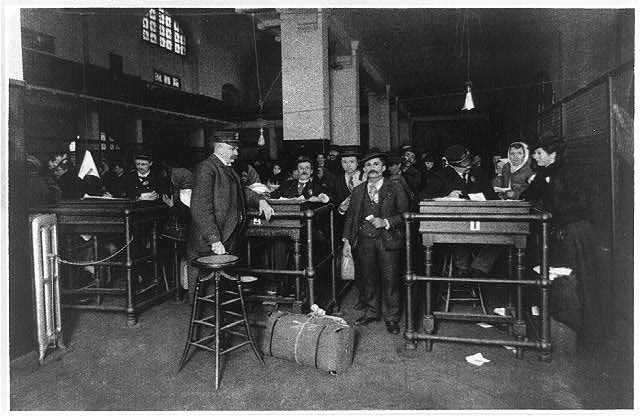
Immigrants getting approval to leave Ellis Island. (Photo: Library of Congress)
In 1931, the celebration was broadcast over a national radio network, and was also transmitted by short waves for the reception of listeners in foreign countries. Broadcasting officials told Ellis Island Commissioner Edward Corsi to direct his annual speech not only to the immigrants on the island, but also to say something to the international audience listening across the globe. While Corsi greeted performers from the Metropolitan Opera and NBC, one of his aides came to him in a panic. He pointed at the concert program; it read, “Given by the Fellow Countrymen of those Immigrants who wait at our Gates.” When Corsi questioned what the issue was, his aide replied: “I’ve just come from a look-in on the Deportation Division. There are only three immigrants on the Island—but I have just seen the guards march nearly 200 deportees into the concert room.” A remorseful Commissioner Corsi later recalled,
“(When) I faced that audience and the microphone, when I was telling the unseen audience in foreign lands how their countries had contributed to the upbuilding of America, I must confess that I felt a tinge of shame. And over and over the words dinned in my ears, “What a Christmas present! Deportation!”
With the end of World War II, the island primarily detained small numbers of “foreign subversives” and media coverage of Ellis Island celebrations became almost non-existent—there was simply no extravagant Christmas production to report on. Brief mentions reflected the changing demographics of the island; in an article inexplicably titled “Christmas Fiesta” the New York Times observed, “All the aliens took part (in the fiesta), except six communists.” By the 1950s, the American Society for the Protection of the Foreign Born began encouraging its supporters to write holiday greeting cards to the dozens of long-term detainees at Ellis Island. The Society also sent a letter to the detained immigrants, hailing their “heroic struggle” and insisted “(this) Holiday Greeting is our way of letting you know that we shall not rest until your freedom is assured.”
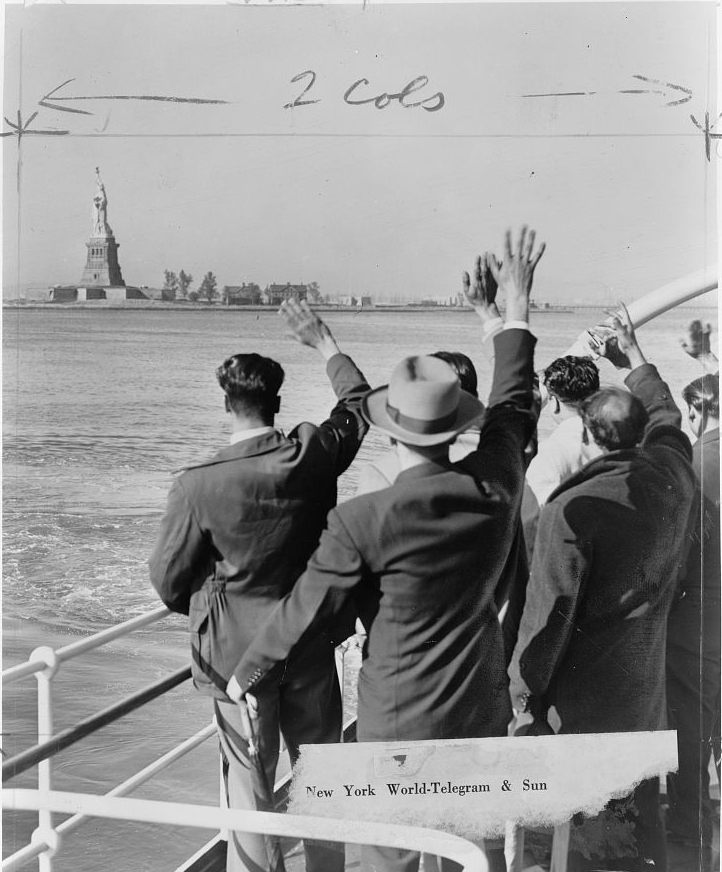
A group being deported in 1952 wave goodbye to the Statue of Liberty. (Photo: Library of Congress)
Thus, in the station’s final years, the Christmastime captivity of foreigners became a rallying point for more modern forms of immigration activism, rather than fodder for evangelist missions. But had the island stayed open into the 1960s, the answer would likely have changed again.
Christmas on Ellis Island turned out to be a litmus test for American attitudes on immigration, a referendum on the political, social, and even spiritual obligations this country has to new arrivals. The tradition continues. This week, after immigration officials announced the continued detention of three Syrian families in Texas, news outlets seized on the story. One headline read: “Syrian refugee families denied parole, now face Christmas in Texas detention facilities.”











Follow us on Twitter to get the latest on the world's hidden wonders.
Like us on Facebook to get the latest on the world's hidden wonders.
Follow us on Twitter Like us on Facebook